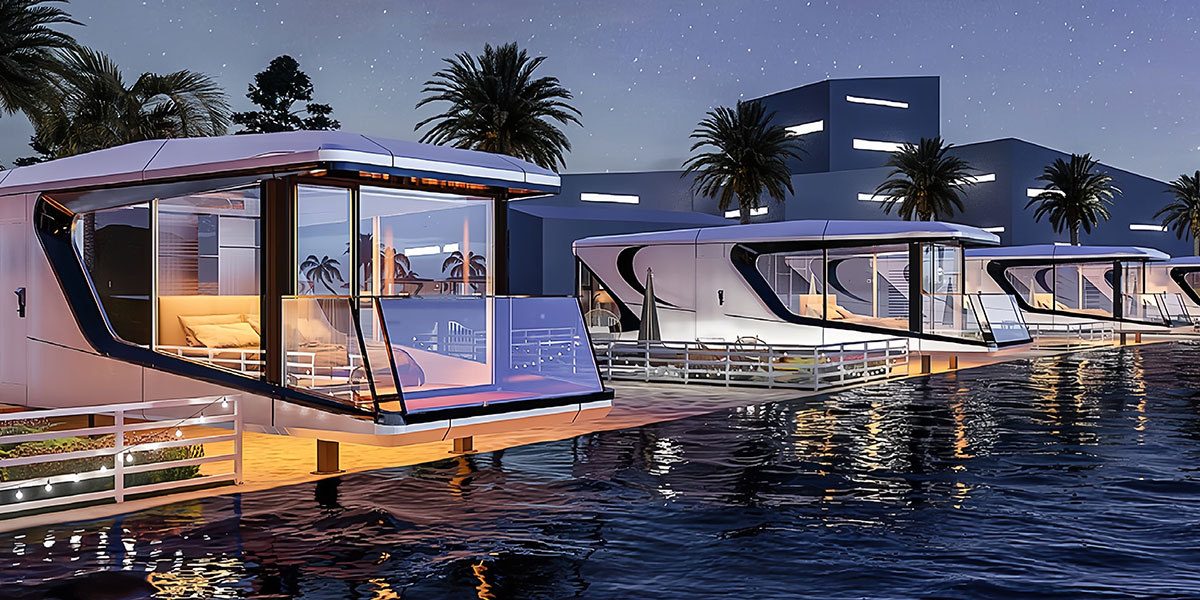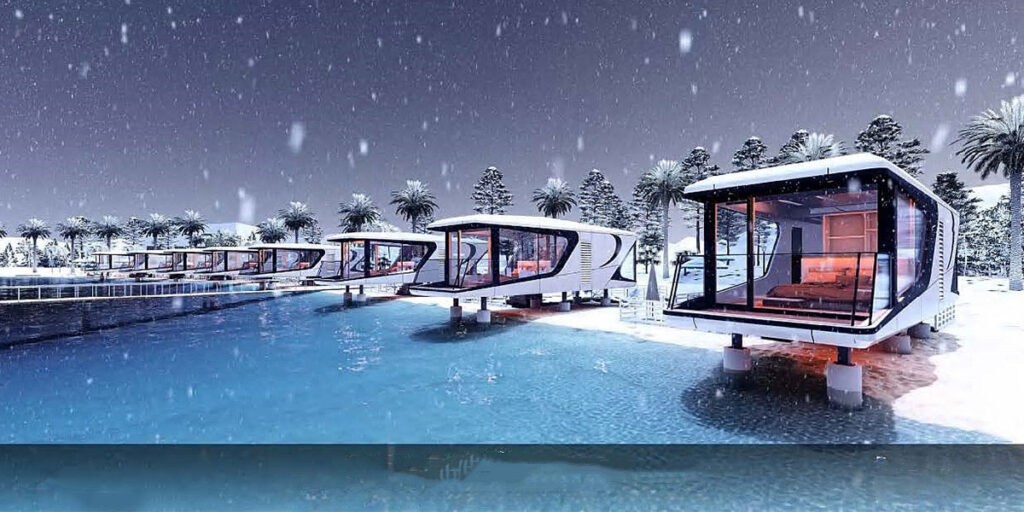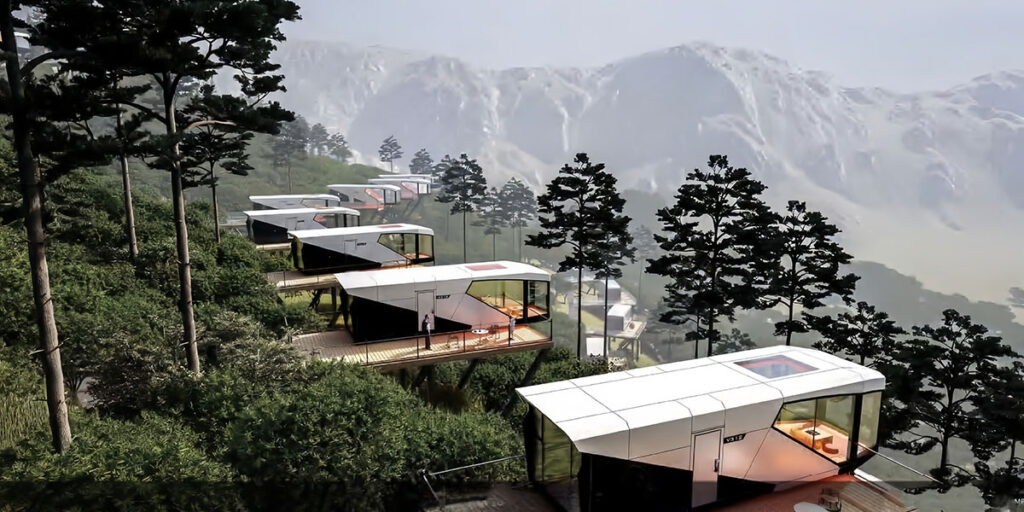
10 Jul Creative Applications of Capsule Houses in Eco-Tourism
Table of Contents
- 1 Key Takeaways
- 2 Understanding Capsule Houses in Eco-Tourism
- 3 Applications of Capsule Houses in Eco-Tourism
- 4 Benefits of Capsule Houses for Eco-Tourism
- 5 Challenges and Solutions for Capsule Houses in Eco-Tourism
- 6 FAQ
- 6.1 What makes capsule houses special compared to other eco-friendly stays?
- 6.2 Can capsule houses work as short-term housing for eco-tourism?
- 6.3 Are capsule houses strong enough for bad weather?
- 6.4 How do capsule houses stay green in places without utilities?
- 6.5 Are capsule houses good for families or groups?
Eco-tourism is growing fast, and people want to enjoy nature without hurting it. Capsule houses are a great solution for this. These small homes mix smart designs with eco-friendly ideas. They provide places to stay that don’t harm the environment much. The eco-tourism market might grow from $295.10 billion in 2023 to $761.39 billion by 2030. This shows that more travelers want green choices.
Capsule homes are not just tiny pods. Their small and smart design helps them fit into beautiful places. They also support protecting the environment. You can find these homes in cities or as small hotels in faraway spots. These tiny spaces show that being eco-friendly can still be cozy and comfortable.
Key Takeaways
Capsule houses are small, green homes that mix comfort with care for nature.
These homes have clever designs and save energy, letting people enjoy nature without hurting it.
Capsule houses can be placed in many spots, like high mountains or city rooftops, giving cool and flexible places to stay.
Staying in capsule houses helps eco-tourism and gives a comfy experience while lowering harm to the planet.
Capsule houses are cheap for owners and visitors, making nature-friendly trips easy and affordable.
Understanding Capsule Houses in Eco-Tourism
What Is a Capsule House?
A capsule house is a small home with all essentials. It uses space wisely and is usually 300 to 500 square feet. Even though it’s tiny, it has a bed, bathroom, and kitchenette. These homes are made with parts that are easy to build and move. This makes them great for short-term or simple living. They are perfect for eco-tourism because they help protect nature.
Feature | Description |
|---|---|
Definition | A compact home with basic needs in a small space. |
Size | Usually between 300 and 500 square feet. |
Design Philosophy | Offers basic home features while saving space. |
Construction | Built with easy-to-assemble modular parts. |
Context | Best for cities or places needing simple, temporary housing. |
Features of a Modern Capsule Home
Modern capsule homes mix smart design with comfort. They use clever storage like shelves and drawers under beds. Furniture can fold or change to save space. These homes have energy-saving appliances and smart systems like voice controls. Everything is designed to be useful and waste nothing.
Feature | Description |
|---|---|
Streamlined Design | Simple look with furniture that serves many uses. |
Functional Minimalism | Focuses on items that are useful and save space. |
Smart Storage Solutions | Includes shelves and drawers to use space better. |
Technological Harmony | Adds smart tools like energy-saving lights and appliances. |
Intelligent Kitchens | Uses advanced tech for climate control and voice commands. |
Why Capsule Houses Are Ideal for Eco-Tourism
Capsule houses are great for eco-tourism because they are green and efficient. Many use materials that are good for the planet and insulation to save energy. They are built quickly without harming nature. They work well in faraway places and can use solar power. Whether camping or staying at a nature resort, these homes are cozy and eco-friendly.
Evidence Description | Sustainability Aspect |
|---|---|
Prefab capsule homes save energy, making them eco-friendly. | Energy Efficiency |
Building them doesn’t harm the environment much. | Minimal Environmental Disruption |
Their design fits well with nature and is sustainable. | Adaptability to Environment |
They work in remote areas and use renewable energy. | Functionality in Off-Grid Areas |
Made with planet-friendly materials and good insulation. | Use of Eco-Friendly Materials |
Built off-site to reduce waste and save resources. | Resource Efficiency |
Applications of Capsule Houses in Eco-Tourism

Remote Eco-Resorts
Picture waking up in a small, cozy capsule house with stunning mountain views. Remote eco-resorts use these homes to offer eco-friendly stays in hard-to-reach places. You can find them in spots like the Swiss Alps, where they blend perfectly with nature. Many have solar panels and energy-saving designs, making them great for travelers who care about the planet.
These capsule houses are more than just a place to sleep. They help you enjoy nature while reducing harm to the environment. Their modular design lets resorts build them quickly without damaging the area. Whether hiking tough trails or relaxing in peace, these homes make your stay green and comfy.
Scenic Nature Destinations
Capsule houses work well in beautiful places where big hotels might ruin the view. Imagine staying in one on a cliff by the ocean or deep in a forest. These tiny homes fit into the scenery without taking away from its beauty.
One great thing about capsule houses is how flexible they are. They can go in deserts, mountains, or near waterfalls. Their small size and eco-friendly materials protect the environment. You can enjoy amazing views without causing harm. Many also have features like rainwater collection and composting toilets, making them even greener.
Tip: When visiting a scenic spot, choose eco-tourism places with capsule houses. They’re not just places to stay—they’re part of the adventure.
Off-Grid Camping and Glamping
If you love adventure but want some comfort, capsule houses are perfect for off-grid camping and glamping. They mix outdoor fun with modern convenience. You can enjoy nature without giving up things like a soft bed or warm shower.
Glamping capsule houses often have solar lights, insulated walls, and small kitchens. They work well in remote areas without regular utilities. Whether camping in the wild or glamping under the stars, these homes let you enjoy nature responsibly.
Their portability is another big plus. You can set them up on beaches, snowy fields, or anywhere else. Capsule houses let you explore hidden places without harming the environment. They’re a win for both adventurers and the planet.
Pop-Up Eco-Tourism Events
Pop-up eco-tourism events offer new ways to enjoy nature. These events use capsule houses as temporary places to stay in special spots. Imagine going to a music festival in a desert or a wellness retreat on a quiet beach. Capsule houses make these events possible without harming the environment.
These homes are quick to set up and take down. Their modular design makes them great for short-term use. Event planners can place them in remote areas without hurting the land. After the event, the capsule houses can be moved to another location. This keeps nature safe and untouched.
At pop-up events, capsule houses often include green features. Solar panels give power, and rainwater systems collect water. Some even have composting toilets to reduce waste. These features make them perfect for eco-friendly events. You can enjoy the event while knowing your stay is planet-friendly.
Note: If you’re attending a pop-up eco-tourism event, choose one with capsule houses. They’re not just easy to use—they help protect the Earth.
Space Capsule Houses in Real-World Use
Space capsule houses aren’t just ideas—they’re already being used. These modern homes are inspired by space travel. Their cool designs and smart technology make them great for eco-tourism in tough places.
You can find space capsule houses in deserts, icy tundras, or even floating on water. They have insulated walls and energy-saving systems to keep you comfy. Built for extreme weather, they’re perfect for adventurous travelers.
These homes often have advanced features. Smart systems control lights, temperature, and air quality. Many use solar or wind power for energy. Their small size saves resources but still offers comfort.
Space capsule houses are also used for research and conservation. Scientists use them as shelters in faraway places. Their portable and eco-friendly design helps with studying animals or nature. Staying in one feels like being part of a mission to save the planet.
Tip: For a one-of-a-kind eco-tourism trip, try a space capsule house. It’s like living in the future while enjoying Earth’s beauty.
Benefits of Capsule Houses for Eco-Tourism
Sustainability and Energy Efficiency
Capsule houses are great for being green and saving energy. They are built to protect nature while giving modern comforts. Many use strong, eco-friendly materials like wood-alu-clad. This mixes the warmth of wood with aluminum’s strength. These materials last long and match eco-friendly goals.
Energy-saving features make these homes special. Some have smart window shades that move with sunlight. This lowers the need for air conditioning and saves power. Some aim to use no extra energy, making as much as they need. Insulated concrete forms (ICFs) keep the inside warm or cool. This cuts heating and cooling costs.
Capsule houses also save water. Models like Ecocapsule collect rainwater and manage water well. These features make them great for faraway places. Whether in the mountains or by the sea, you can enjoy nature without hurting it.
Did you know? Capsule houses fit into nature while staying comfy and eco-friendly.
Cost-Effectiveness for Operators and Guests
Capsule houses are good for the planet and your wallet. For owners, they need less land and fewer materials to build. Their modular parts are easy to put together, saving money. Energy-saving systems also lower bills, making them a smart choice.
Guests find capsule hotels affordable and useful. These tiny homes have basics like a bed, bathroom, and kitchenette. They cost less than regular hotels, making them great for solo travelers or backpackers. Operators can keep prices low because of their simple design.
Even though they’re small, capsule houses don’t lack style. They use space wisely with foldable furniture and smart storage. This makes sure guests have everything they need for a cozy stay.
Tip: Choose a capsule house for your trip. It’s cheap and eco-friendly.
Unique Guest Experiences in Compact Spaces
Capsule houses offer more than just a place to sleep. They use every bit of space to create a cozy and smart home. Imagine waking up in nature with systems that adjust lights and temperature for you.
These homes focus on simple living. They help you enjoy nature and live in the moment. Many are in beautiful places like forests or deserts. Their small size blends into the scenery, making your stay special.
Capsule houses also include modern tech for travelers. Voice-controlled gadgets and energy-saving tools add comfort. Whether glamping or at an eco-event, these homes mix luxury with sustainability.
Callout: Capsule houses show that small spaces can be stylish and useful.
Flexibility for Diverse Locations
One great thing about capsule homes is their ability to fit anywhere. Whether it’s a mountain retreat, a beach getaway, or a desert stay, these tiny homes can work. Their small size and smart design let them blend into nature without causing harm.
These homes are made to handle tough environments. In rainy or snowy areas, they can stand on stilts to stay dry. In hot places, their insulation keeps them cool, and solar panels provide power. Some even float on water, giving travelers a chance to live on a lake or river.
Did you know? Capsule homes can be adjusted to match their surroundings. They can fit into forests, deserts, or cities without looking out of place.
Another big plus is their portability. You can move a capsule house to remote spots where regular buildings can’t go. Imagine placing one in a jungle or on a cliff with amazing views. These homes are designed to protect nature while letting you enjoy it.
Capsule homes also work well in cities. They can fit on rooftops or small empty spaces to create housing or unique stays. Their modular design allows stacking or arranging them creatively, saving space.
Tip: When visiting a special location, choose a stay with capsule homes. They’re eco-friendly and let you enjoy beautiful places comfortably.
Challenges and Solutions for Capsule Houses in Eco-Tourism

Making Small Spaces Comfortable
Living in a capsule house might seem tight, but smart designs help. Clever layouts and furniture make small spaces feel bigger. Beds with storage, foldable tables, and hidden shelves save space. Large windows and natural light create an open and airy feeling.
Technology adds comfort too. You can control lights or temperature with your voice. These features make the space modern and welcoming. Privacy is also important. Many capsule houses have soundproof walls and curtains for personal areas. With these details, small spaces can feel cozy and private.
Tip: Pick a capsule house with smart storage and tech tools. They make small spaces much more enjoyable.
Solving Zoning and Regulation Problems
Building capsule houses isn’t always easy due to strict rules. In some places, zoning laws and building codes slow down projects. For example, the U.S. and Australia have tough regulations. In Europe, some people resist smaller living spaces.
Developers are finding ways to fix this. In the U.S. and Australia, they work with local governments to speed up approvals. In Europe, a capsule house showroom in Paris changed minds. It attracted 10,000 visitors in one month, showing people like the idea.
Region | Problems | Solutions |
|---|---|---|
U.S. | Strict zoning and building rules | Partnering with local governments to simplify processes |
Australia | Tough building codes | Partnering with local governments to simplify processes |
Europe | Resistance to small living spaces | Paris showroom success with 10,000 visitors in one month |
Note: Developers are working hard to solve these issues so capsule houses can grow in eco-tourism.
Changing Public Opinions
Some people think capsule houses are too small or uncomfortable. They may doubt if these homes can offer a good experience. Changing these views takes time and effort.
Real-life examples help. Eco-tourism resorts using capsule houses show their benefits, like being green and stylish. Guests often praise the cozy feel and amazing locations. Positive reviews and stories help change opinions.
Education is key too. When people learn about eco-friendly materials and energy-saving designs, they see the value. Capsule houses aren’t just tiny—they’re smart, sustainable, and great for eco-tourism.
Callout: Unsure about capsule houses? Try staying in one. You might love the experience!
Maintenance and Durability Considerations
In eco-tourism, keeping capsule houses in good condition is important. You want a comfy stay, right? That’s why these homes are made to last and are easy to care for. Strong materials help them handle bad weather and frequent use.
Many capsule houses are built with steel, aluminum, or strong wood. These materials don’t break easily, making them great for tough places. For example, in rainy or snowy areas, sloped roofs and water-resistant layers stop leaks and damage.
Taking care of them is simple. Their modular design lets you replace parts like windows or panels easily. This saves both time and money. Plus, their small size means there’s less to clean or fix. You’ll have more time to enjoy your trip instead of worrying about repairs.
Eco-friendly systems like solar panels or rainwater collectors might need checks sometimes. But don’t worry—they’re made to be easy to use. Even if you’re not great with tech, you can handle them without trouble.
These homes are built to survive in harsh conditions. Whether on a windy hill or in a wet forest, they’re made to last. This makes them a smart choice for eco-tourism operators and travelers like you.
Tip: Before staying in a capsule house, ask about its upkeep. A well-kept home means a stress-free trip!
Capsule houses are changing how people enjoy eco-tourism. These small homes mix comfort with being eco-friendly. They let you explore nature without causing much harm. Their green design and low cost make them great for travelers and owners. Found in forests or on cliffs, they offer amazing stays while caring for the planet.
Think about a future where capsule homes change travel. You could wake up to stunning views, knowing your stay helps the Earth. It’s not just about the place—it’s about traveling in a better way.
Tip: When planning your next trip, try a capsule house. It’s a simple way to help the planet.
FAQ
What makes capsule houses special compared to other eco-friendly stays?
Capsule houses are small and smartly designed. They save space and reduce harm to nature. Unlike bigger eco-friendly places, they fit into the environment and feel cozy.
Can capsule houses work as short-term housing for eco-tourism?
Yes, capsule houses are great for short stays. Their modular design makes them easy to set up in remote spots. They’re perfect for temporary use while being kind to nature.
Are capsule houses strong enough for bad weather?
Yes! Capsule houses are made with tough materials like steel and insulated walls. They can handle rain, snow, and heat, making them safe in harsh weather.
How do capsule houses stay green in places without utilities?
Capsule houses use solar power and collect rainwater. These features let them work in off-grid areas while staying eco-friendly.
Are capsule houses good for families or groups?
Even though they’re small, capsule houses have smart layouts and foldable furniture. They can fit small families or groups comfortably, offering a cozy and practical space.



